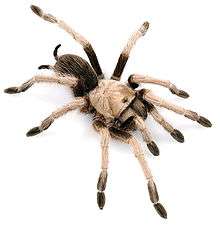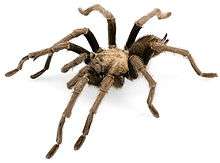Aphonopelma iodius
Aphonopelma iodius is a species of spider in the tarantula family Theraphosidae, found in United States (California, Nevada, Arizona and Utah).[2] A 1997 paper combined it with three other previously described species (A. angusi, A. melanium, and A. nevadanum) into a single species, calling it "A. iodium".[3] However, iodius is a neuter comparative adjective and is the correct form.[1] A. iodius is common in the Mojave Desert to the west of the Colorado River.[3] As of 1997, the distribution of A. iodius farther south or west into the Mojave Desert or North into Nevada and Utah was undetermined.[3]
| Aphonopelma iodius | |
|---|---|
 | |
| Female | |
 | |
| Male | |
| Scientific classification | |
| Kingdom: | Animalia |
| Phylum: | Arthropoda |
| Subphylum: | Chelicerata |
| Class: | Arachnida |
| Order: | Araneae |
| Infraorder: | Mygalomorphae |
| Family: | Theraphosidae |
| Genus: | Aphonopelma |
| Species: | A. iodius |
| Binomial name | |
| Aphonopelma iodius (Chamberlin & Ivie, 1939)[1] | |
| Synonyms[1] | |
| |
Taxonomy
The taxonomy of Aphonopelma is complex and has been revised many times.[3] The formerly recognized A. melanium, A. angusi, and A. nevadanum were found to be in synonymy with, and were folded into, A. iodius.[3] In the same study two new species, A. joshua and A. mojave, were also recognized as geographically and phenotypically distinct.[3]
Natural habitat
A. iodius lives in webbed burrows under the surface of desert areas of California, Nevada, and Utah. They often obstruct the entrance to their burrows with a silken or silk and dirt plug to protect against heat and predators.[3]
In captivity
In the pet trade A. iodius is known by many names, such as the Great Basin blonde, Fresno County blonde, desert tarantula, Salt Lake City brown, northern blonde. The species is harder to find in the tarantula trade than many of the more colorful species, but can still be purchased at a slight premium.[4]
References
- "Taxon details Aphonopelma iodius (Chamberlin & Ivie, 1939)", World Spider Catalog, Natural History Museum Bern, retrieved 2019-06-09
- Hamilton, C.A.; Hendrixson, B.E. & Bond, J.E. (2016), "Taxonomic revision of the tarantula genus Aphonopelma Pocock, 1901 (Araneae, Mygalomorphae, Theraphosidae) within the United States", ZooKeys, 560: 1–340, doi:10.3897/zookeys.560.6264, PMC 4768370, PMID 27006611
- Prentice, Thomas R. (1997), "Theraphosidae of the Mojave Desert west and north of the Colorado River (Araneae, Mygalomorphae, Theraphosidae)", The Journal of Arachnology, 25: 137–176
- Swift (2019), Tarantulas New Arrivals (website)